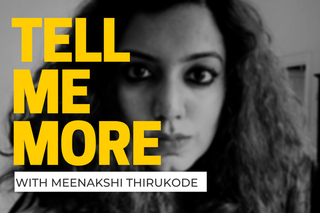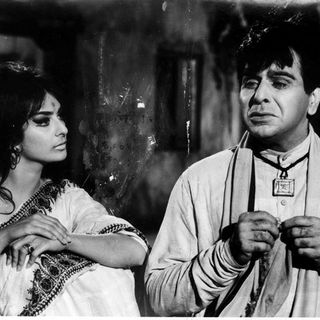
Tell Me More: Talking Dissent And Hope In India’s Art World With Meenakshi Thirukode
“It gives me hope that there is a generation that’s not going to just be like business as usual.”

In The Swaddle’s interview series Tell Me More, we discuss crucial cultural topics with people whose work pushes societal boundaries.
Meenakshi Thirukode is a writer, researcher, and educator in the fine arts, and has previously worked as a curator. She runs ‘School of Instituting Otherwise,’ which is a space of unlearning, dedicated to navigating ‘study’ as a radical tool of political agency. She’s also co-building ‘Pact of Silence – How To Break It?,’ a project conceived in India’s post #metoo landscape that seeks to build more equitable spaces and a non-conventional art system. The Swaddle’s Aditi Murti spoke to Meenakshi about the past few years of dissent in India’s art world and her predictions for future resistance.
The Swaddle: This particular year began with a rather solemn end to a high stakes attempt at dissent in the art world, where Scene and Herd — an anonymous account that posted allegations of abuse in the Indian art space — had to settle in the lawsuit that artist Subodh Gupta had filed against them. How did you and others you know in the arts receive this news?
Meenakshi Thirukode: So I guess I can’t speak for everyone with regards to the settlement. But I do think that, for me, at least, it shows that there’s a lot more to this story than what we see played out in the public. Often, we make assumptions about maybe how things go within the legal system, how movements go. What I noticed was a lot of entitled opinions, when actually we’ll really never know what happened behind the scenes, right? We don’t really know what kinds of potential pressure or intimidation tactics were utilized to get to the settlement. If you’d followed that account from 2018-2019, you’d see that they weren’t just calling out people, but also raising important questions about how abuse manifested in the art world, like say, financial abuse. Yet, all people were worried about was who this person could be, and why they were anonymous. I heard a lot of people say things like ‘pseudo-activism’ and make many judgments about why they had to do this.
I mean, these people fought a legal battle. Does anyone talk about how much money might have gone? Like pro bono is never only pro bono — there are always financial overlays to the strain of a legal battle. What’s the follow through? What are the mental health issues these individuals dealt with? How did their families cope? It just feels like everyone’s jumped on a bandwagon instead of really sitting and thinking this issue through.
Related on The Swaddle:
#MeToo Is Making People Confront Their Trauma. And Most Are Unequipped To Do So.
TS: One glaring issue with working in the arts, both in India and globally, is that it’s a very informal structure that can put younger people and people from marginalized backgrounds at risk. How do are these power structures constructed and preserved?
MT: So the art world is mostly an informal sector, yes. Something like an auction house functions as a proper corporate entity, and a museum functions like a cultural institution. Then there’s art fairs, which is also very corporate, and galleries which revolve around one founder with a small team. But in my experience in India, there hasn’t been anything said in these spaces about an internal committee or even workshops for awareness in terms of workplace ethics and standards, what’s appropriate and what’s not. Like, I remember there was a case highlighted in @herdsceneand related to Sotheby’s, and Sotheby’s did have an IC procedure and legal entity to deal with addressing the call out and Sotheby’s did have a corporate procedure and entity to deal with this. Sotheby’s is an international organisation and functions differently but Indian institutions are mostly problematic — like remember what happened with the Art Fair during the Anti-CAA-protests? In fact, I think this was one of the few times the public got to see how such institutions function. But for some of us who actually worked in these spaces, we’ve been seeing this stuff for a long, long time.
And I think people get away with this stuff because, in the larger scheme of things, what is the art world in India, right? Like who cares? The point is that so much of it is dependent on money and elitism, so the way the Art World functions is mostly about capital and money and power. So, when these events and protests happened, some people slowly started engaging with and welcoming politics into the realm of culture and art. They realized that you don’t really need to work at a gallery to be an artist, right? There’s so many different ways to engage with art — you could be an educator, you could do your own thing, have your own space — anything!
TS: I was thinking of global dissent in closed-off spaces like the arts over the past few years, and the most powerful example that comes to my mind is Jaishri Abhichandani’s feminist performance in front of the the Met Breuer, while they held a retrospective on her alleged abuser Raghubir Singh. That was a stunning act of dissent, because it gave us a whole new perspective on how to engage with art made by an artist who may also be an abuser. Do you think there’s growing, untapped potential for similar acts of dissent in the Indian scene?
MT: Oh yeah. It might not be the exact visual as Jaishri’s protest, but definitely. Say for example, if you open up a space and give voices to marginalized artists in particular — that in itself is powerful. That’s also a form of refusal of doing things the way it’s supposed to be, you know? Other low-key forms of dissent include different artists running community study and reading groups — it’s not visible like an art project, but it’s important. It’s about choosing to do things whether people are seeing or not.
Personally I can think of two important examples — AryaKrishnan’s Sweet Maria momument, which exists as a powerful art project and a space to read queer literature at once, as a means to give visibility to an activist who was murdered, and for all that she stood for. Then there’s Jyotsna Siddharth, who’s doing a lot of stunning work around the idea of love and courtship through an anti-caste lens via ‘Project Anti Caste Love’, which takes apart the politics of modern-day relationships. Who we choose to love and what it means is quite a powerful question.
Related on The Swaddle:
Tell Me More: Talking Caste and Marriage With Jyotsna Siddarth, Founder of Project Anti‑Caste Love
TS: I saw a major divide between the way young artists threw themselves into working for the protest in comparison to… silence from renowned artists. Why would prominent artists step away from offering a moral or political voice to a citizen’s protest?
MT: See, with India, the art markets are governed by money and power. So, before the 2008 crash, the Indian art market was huge, and heavy on investments, because art is an appreciating asset. In India and China, lots of contemporary artists were selling for mega amounts of money at that time. This of course put together the culture of the ‘genius artist’ and a lot of these abuse that we see in India’s art culture. If you’re coming from a smaller town or village and want to make it in the art world, you only have this vision of being wined and dined in blue chip galleries and limousines. I mean, that’s power and all of these guys are into that.
After the 2008 crash, a lot of these artists practically disappeared from most memory because there wasn’t much value for their work anymore. But now, as you pointed out, there’s a whole new generation that’s looking at art from a new, political perspective. And then there are these older generation guys desperately trying to hold on to the glory of being genius artists that everyone wants to look up to. This also creates a certain hole between the older generation and the newer generation, because a lot of young people look up to these artists, and these artists can easily manipulate young people who want to mould themselves in a particular way. So there’s not much of a response to what really matters.
TS: You told me that you had to give up a lot for holding a particular stance. What type of stance was this?
MT: I can’t understand people who continue to work in gallery systems, knowing what they know about it. You want to put together mentorship programs for young artists, but you’re working at a gallery? I mean, you can, it’s your choice. But I think a gallery is an inherently violent space, and I can’t reconcile with people who work in them because of my politics. I’m not saying that I’m better than everybody else. Not at all that. I think I just set a certain kind of model for myself and it’s very difficult for me to see people do this.
I mean, I believe in transformation. I do think that people are capable of being accountable to themselves or to people that have harmed and they can change. But I don’t see that happening because everyone’s gone back to business as usual. Only, people want to change the language they speak a bit — everyone wants to create spaces, be a social justice curator, talk about capitalism and politics and just overall be great at the English they speak. But, you haven’t actually done the work? So, I just let go.
I was having this conversation with a friend, and thinking about returning to an institutional space, and they said something to the tune of me not willing to compromise now, but that one day I’ll be able to do so. I found that funny, because it’s always people who speak up about abuse that have to compromise. Nobody big is compromising. And I realized — no, I don’t want to compromise. If I were an institution, I’d want to hire all the people who spoke out — if I were so focused on living up to the hashtags I put out, I’d want to work with these people.
TS: What do these past few years bode for the future of dissent in India’s art scene. Do you feel hopeful or bleak about it?
MT: I want to hope! I do think that a lot of young people, even those working in institutions in the art world are super smart and incredibly aware of what has happened, and what needs to be done. And I really do think and trust that they are going to be building these spaces much more differently than what was before. People are more likely to discuss — students in particular — they’re likely to do workshops and take learnings back to the institutions they work at or their daily lives. It gives me hope that there is a generation that’s not going to just be like business as usual.
I’m somewhere in between the previous and the new generation and I think my investment is in what I can do with some of my ideas in a non-hierarchal way. And then there’s the up-coming generation. So, yeah, I mean, I do see it. I see a lot of good people in some of these places. And I just hope that they don’t get co-opted or, manipulated or get bogged down. But I think they’re completely capable of taking care of themselves, so I don’t need to worry about that. Let’s see what happens.
This interview has been condensed and edited for clarity.
Aditi Murti is a culture writer at The Swaddle. Previously, she worked as a freelance journalist focused on gender and cities. Find her on social media @aditimurti.
Related


Woe Is Me! “How Do I Deal With My Defensive Best Friend?”
